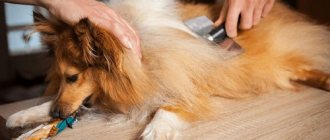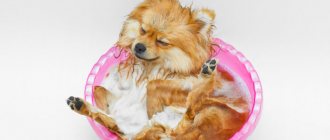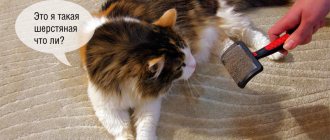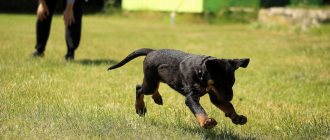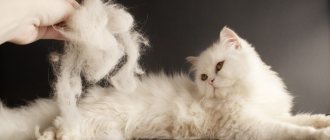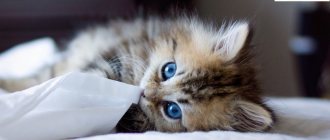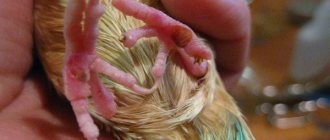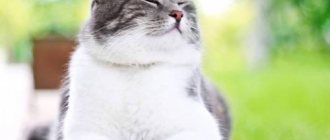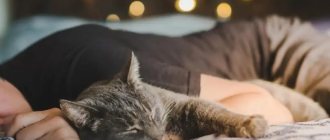One of the indicators of a dog's health is its coat. Smooth, shiny or thick, silky hair often tells the dog owner that everything is in order with the dog’s health. Almost every dog owner knows that 2 times a year dogs experience active hair loss, the so-called seasonal shedding, during which the dog feels normal, and therefore does not worry about its health.
Wool structure. In dogs, hair follicles are combined into groups (bundles) consisting of one, longest, primary (central) hair, surrounded by thinner and shorter secondary (additional) hairs (in puppies there are no secondary hairs). The density of the coat depends on the age and breed of the dog. The softer the wool, the thicker it is. For example, a German Shepherd has 1 sq. There are 100-300 groups of follicles per cm of skin, and 400-600 in dogs with soft hair. The number of groups of hair follicles is determined at birth, but young puppies only have downy hairs that are very soft to the touch. With age, the angle of inclination of the hair to the surface of the skin decreases to approximately 45 degrees until an adult dog.
The dog's owner begins to show his concern when he notices that his friend's once shiny coat is becoming dull and starting to fall out.
Dogs shedding is an absolutely normal phenomenon, but this fact does not in any way save owners from worrying about the pet’s health; in addition, no one is likely to like fur all over the house.
Dog hair and its purpose
Wool is of great importance for a pet because it provides protection from environmental factors. It protects the dog from parasites, infectious diseases and bad weather. It is worth noting that wool is an indicator of the dog’s health. Soft, silky and shiny fur means that the pet feels good and gives no reason for concern.
Outdoor dogs have two shedding periods per year, during which the winter and summer coats change.
Replacement of coat in dogs does not begin by accident. The signal for molting is a change in the length of daylight hours. When daylight hours lengthen, spring molt begins, and when it decreases, winter molt begins.
In females, molting can occur not only in spring and autumn, but also during the sexual cycle and immediately after childbirth. Additionally, sometimes hair loss can occur due to very strong stress (change of owner, moving to another area).
Bitches often shed before going into heat. This is due to changes in hormonal levels. In this case, after estrus, the condition of the coat will be restored.
During the spring shedding, the dog sheds a lot of undercoat, which retains heat. In autumn, on the contrary, some of the thick hair falls out and the undercoat grows. In terms of time, molting lasts 1-2 weeks. In dogs that live in an apartment or in warm rooms all the time, shedding occurs little by little and all the time.
Hair doesn't all fall out at the same time. Shedding begins from the back of the body and gradually moves to the front. A dog's winter coat is thicker than its summer coat and serves as good protection from the cold.
Feeding the dog
In order for your dog to be healthy, active, and have a shiny coat, you must organize complete feeding, balanced in proteins, fats, carbohydrates, minerals and vitamins. If there is a lack of vitamins in the diet, vitamin preparations (vitamins for dogs) must be added to the diet.
A dog's fur may fall out in the summer, even if it is practically healthy. This happens to those dogs whose owners use shampoos intended for humans when bathing their dogs. The dog owner needs to know that the structure of the skin of a dog and a person is different, as a result, human shampoo can provoke shedding and an allergic reaction in the dog. However, you can purchase a special shampoo that will prevent healthy hair loss.
You should not bathe your dog more than once a month. When bathing, use lukewarm water. Using hot water will cause your dog to become stressed.
What breeds don't shed
Unfortunately, there are no breeds that do not shed at all. Some dogs shed significantly less hair than others, but they still shed some hair. These breeds include the following:
- Irish Water Spaniel.
- Soft coated wheaten terrier.
- Yorkshire Terrier.
- Poodle.
- Boston Terrier.
- Welsh Terrier.
Almost all terriers and lap dogs shed little, but if you want a pet whose hair does not fall out at all, then special hairless dogs have been bred that have no hair at all, so they cannot shed even during the season.
Help from the owner during seasonal molting
During seasonal shedding, owners should help their dog go through this period painlessly. The animal needs quality care from you. Don't be alarmed if your dog sheds a lot. Any veterinarian will tell you what to do during this period, but the measures for caring for your dog are very simple.
First, brush your pet's fur regularly to ensure timely change of hair follicles.
Grooming different breeds of dogs requires different amounts of time. It is easier to care for dogs of smooth-haired breeds (Great Danes, Doberman Pinschers and the like), for which it is enough to simply clean the coat once every 3-4 days with a brush, not too thick, but hard enough to remove dust and dirt. It only takes 10-15 minutes. A hard brush should be used carefully so as not to scratch the animal’s skin. Dogs with medium length hair must be combed with special metal, horn or wooden combs at least 2 times a week. At the same time, dead undercoat is easily removed and tangled hair is combed.
Long-haired dogs are very beautiful, but they need daily brushing. For dogs with long, thick hair, loose hair can be removed using a wire brush. A wide comb is good for combing out mats of fur on the paws. Sometimes caring for the hair of wire-haired dog breeds requires the intervention of a specialist.
In order for a dog to shed without any complications, owners must follow the rules of grooming.
In addition to shedding, hair loss in dogs is observed with diseases of the gastrointestinal tract, kidney diseases, helminthic infestation, ectoparasites, etc.
In the case when increased shedding in a dog is accompanied by changes in its usual behavior, the appearance of additional symptoms of a particular disease, you must urgently contact your veterinary clinic.
Veterinary experts divide the causes that can cause hair loss in dogs into two large groups - hormonal and non-hormonal.
If you notice hair loss in your dog on symmetrical areas of the body, then the cause of hair loss most likely lies in a hormonal imbalance in the dog’s body. In the case where there is no such sequence, and hair loss occurs in different parts of the body, then you should think about whether the dog has a skin disease.
Hormonal causes of hair loss in dogs. Hormonal causes that can cause hair loss include:
Hyperestrogenism is an excessive intake of estrogen into the dog’s body; as a result of an imbalance of sex hormones, dog owners notice severe hair loss in the genital area. At the same time, there is a sharp enlargement of the vulva in females and swelling of the foreskin in males.
Hypoestrogenism is a lack of hormones in a dog’s body. This disease is more common in middle-aged spayed female dogs. With this disease, the dog first experiences severe thinning of the hair near the genitals, and subsequently throughout the body; dog owners additionally note a slowdown in the rate of hair growth.
Hypothyroidism is a disease accompanied by an acute deficiency of thyroid hormones in the dog’s body. With this disease, the hair becomes dry and brittle. Then hair loss begins on the back, chest and neck. In addition, owners note that the dog is lethargic and apathetic. The dog avoids physical activity, a sharp increase in body weight occurs, and the degree of protection against various infections decreases.
Hyperadrenocorticism or Cushing's syndrome is a disease when excess cortisol is produced in a dog's body. The disease is accompanied by severe loss of hair throughout the body. Additionally, this disease is characterized by a strong gain in body weight, constant thirst and frequent urination. During a clinical examination, the dog has swelling and drooping abdomen.
Diabetes mellitus - this disease in dogs leads to the fact that the coat and undercoat become dull, and the hair begins to fall out. A sick dog is thirsty all the time. On examination, the mucous membrane of the mouth is dry. The dog eats more than usual, but the weight does not increase or begins to fall quickly. Tends to lie down most of the time and refuses long walks. The smell from the mouth is unpleasant (bad breath in dogs), similar to rot (diabetes mellitus in animals, diabetes insipidus in animals).
Veterinary experts include non-hormonal reasons leading to hair loss in dogs:
Allergies in dogs. In recent years, hair loss has become common in dogs as a result of an allergic reaction to various components in food or treats given by the owner (food allergies in animals). As a result of the systematic exposure of the allergen to the dog’s body, it develops atopic dermatitis, accompanied by rashes, swelling and redness of certain areas of the skin, and hair loss.
In addition, the allergic reaction may be accompanied by itching (itching in dogs), restlessness, and drooling (drooling in dogs).
Parasitic diseases. The cause of hair loss in dogs can be infestation of the dog with lice eaters, ticks, fleas (fleas in dogs). In addition to them, subcutaneous parasites can be external irritants leading to hair loss (Sarcoptic mange in dogs, demodicosis in dogs, treatment and prevention of demodicosis in dogs). Worms in dogs can lead to parasitic dermatitis and, accordingly, hair loss in dogs.
Yeast infections. Hair loss in dogs can be caused by skin diseases such as microsporia and trichophytosis, which are dangerous for humans. Dog owners note the presence of scaly, crusty, rounded areas of skin ranging from 12 to 50 mm in diameter. In the center of such formations we find a complete absence of hair with a red ring on the periphery. Mostly, fungal diseases affect areas of the skin with high humidity (skin folds, armpits). Bulldogs, Shar-Peis and other breeds that have many folds on their body are most susceptible to this disease. Dandruff of varying degrees of severity (dry type, wet, complicated) can lead to hair loss over the entire surface of the body.
Bacterial skin infections . The most common diseases in this group are pyoderma and staphylococcal infection in dogs.
Zinc deficiency in the dog's body. If there is a lack of zinc in a dog's body, its skin becomes hard, scaly, and without hair, especially on the face, nose, elbow and hock joints (zinc deficiency in animals). If there is a lack of zinc in a dog's body, some owners notice cracking of the pulp on their paws. It has been noted that the most sensitive to zinc deficiency are dog breeds living in the north of the country. Solar dermatitis . With solar dermatitis, hair loss in dogs mainly occurs on the animal's face. Dog breeds with poorly pigmented skin on the nose are most susceptible to this disease. Owners of dogs with a similar problem should keep in mind that in addition to hair loss and the appearance of skin ulcers, this dermatitis will lead to a large number of autoimmune problems.
Treatment of hair loss in dogs
If the cause of a dog's hair loss is seasonal shedding, the dog owner should not take any therapeutic actions; it is enough to follow the rules for caring for the dog's coat. If the cause of hair loss is certain diseases of the dog, then you need to contact the veterinary specialists of your veterinary clinic. A veterinarian will conduct a thorough clinical examination, and if necessary, blood tests, stool samples, skin scrapings, etc. will be taken. to exclude those diseases that were carried out above and prescribe appropriate treatment. For more information, see our article – Dermatitis in Dogs.
Regardless of the cause of hair loss, dog owners are advised to introduce special vitamin complexes into their diet that stimulate hair growth. In pet stores and veterinary pharmacies, to maintain hair in normal condition, they sell B vitamins, vitamin D, H and F, amino acids, and zinc chelate. Dog owners can use flaxseed oil (contains vitamin F), beef liver (vitamin H), lamb meat, liver, whey, brewer's yeast as a source of vitamins in their dog's diet - they contain B vitamins.
How to get rid of cat allergies?
Unfortunately, this disease cannot be completely cured. You can only reduce the frequency and severity of symptoms. And there is a way to do this:
- Take medications - this option is suitable for those who do not have a cat at home, but have contact with the animal at work, at a party, or on the street. Antihistamines, aerosols, and nasal sprays can help relieve symptoms and prevent attacks.
All these treatment methods are prescribed by a doctor after diagnosis. You should not self-medicate; it is better to turn to professionals. Thus, at the AllergoCity clinic, qualified doctors - allergists and immunologists - conduct consultations. Patients are received daily, including weekends and holidays. Our specialists make home visits, where they conduct an examination, give advice, prescribe treatment and can even take tests.
Preventing hair loss in dogs
Prevention of hair loss in a dog should be based on the organization of adequate feeding of the dog, depending on its physiological state (basics of feeding dogs, feeding pregnant females, feeding lactating dogs, feeding aging dogs, feeding puppies, golden rules of rational feeding of dogs). When feeding your dog, try to choose anti-allergenic food. When your dog is shedding, you need to brush it daily to remove dead hair that can cause skin irritation.
In order to prevent off-season shedding, dog owners must provide their pet with:
- regular flow of fresh air into the room;
- daily physical activity;
- The dog's resting places should be away from heat sources.
It's no secret that pets who sleep and rest near heating appliances shed a lot. This should not be done under any circumstances, because the heat causes the dog’s skin to dry out and the hair begins to fall out.
And also do not forget to systematically ventilate the room where the animal is located. Cool air lowers the temperature in the room and helps the dog not overheat. Physical activity plays a huge role in maintaining a dog’s health - walk with your pet every day, involve it in active games, the pet should experience new emotions and enjoy life. Follow the rules of grooming.
The animal also sheds heavily all year round due to internal diseases or parasites, which leads to a decrease in immunity and a deterioration in the pet’s well-being. In this case, alarming symptoms should prompt a visit to the veterinarian, he will conduct an examination and prescribe treatment.
Domestic dogs that live in an apartment permanently are susceptible to hormonal imbalance. Proper nutrition and regular exercise will help eliminate disorders.
Hair loss as an alarming symptom
Some owners pay attention to an unusual smell for dogs, which confirms the abnormal functioning of the skin glands. Why did it happen so? There can be many reasons for this unpleasant phenomenon - from low-quality shampoo to food scraps eaten on the street.
The coat sheds a lot due to stress. Fights, injuries, visits to the veterinarian and other shocks can trigger hair loss, however, this process should not last all year round. Perhaps the unrest triggered some disease that was in a chronic form.
Many owners are interested in why shedding occurs after giving their pet a treat. Why did it happen so? The fact is that even a healthy dog can suffer from an allergy that manifests itself after eating a certain product, and you should not experiment with treats.
If after such an episode the fur sheds, and the pet has lost weight and turns away from its usual food, then the owners should be wary and take the dog to a specialist. In addition, the allergic reaction may be accompanied by itching, agitation and drooling.
Unexpected shedding often indicates a dangerous illness - a non-food allergy. The reaction of the animal’s body in this case is caused by inhalation of polluted air, products of flowering plants, or lying on synthetic bedding.
Every pet owner should know how many times a year to treat their dog with anti-parasite products and what to do if the dog is directly infected. Flea and tick bites provoke scratching, which leads to hair loss, and if the pet has lost weight and cannot grow a thick coat for a long time, it is worth checking your four-legged friend for the presence of worms. Timely treatment minimizes unpleasant consequences and helps get rid of symptoms.
What should the owner do?
To determine whether this process has begun in your dog, you need to pay attention to the floor, sofa, bed, etc. If tufts of fur are detected, we can conclude that the dog has begun to change its coat. Moreover, at this time the animal begins to behave differently. The dog itches a lot, rolls on the ground, rubs against furniture. What to do when your dog sheds a lot?
Solving the problem of out-of-season shedding
Having found out the reasons for the unusual condition of your pet, do not forget about regular combing of the fur; you should resort to this procedure both in summer and winter. Brushes made of natural bristles - pork or horse bristles - are best suited for this purpose. A pet with a long and thick coat should be combed once a week, carefully unraveling tangles and removing dead hairs. Smooth-haired animals need grooming a little less often; a medium-hard brush is suitable for them.
Decorative breeds of dogs, for example, Yorkshire terriers, need periodic haircuts with special scissors. Experienced breeders use special clippers for this purpose, which allow you to create a short, hygienic hairstyle in the summer and maintain the beauty of the coat all year round.
Changing food is also a solution to the problem faced by owners of furry pets. A dog sheds all year round if it does not receive all the necessary substances to maintain health. What to do in this case? Properly selected dry food contains essential vitamins and fatty acids, as well as valuable microelements. Often, correcting the diet allows you to get rid of troubles, especially if your pet has recently lost weight.
Hygiene plays a significant role in maintaining the beauty and health of a dog’s coat. It is not enough to simply clean the fur from dirt and dust in bad weather; the pet needs a bath.
What should the owner do? An animal that is constantly outdoors in the private sector in the summer is rarely washed. However, dogs that spend maximum time in the fresh air are practically not susceptible to slow hair loss, the reasons for this lie in regular physical activity and adaptation to environmental conditions.
A domestic dog sheds in summer and winter, and its owner is trying to figure out why this happens. Whatever the reasons for hair loss, the dog must be accustomed to water procedures from an early age.
To keep your pet healthy all year round, it is washed with a special shampoo that repels fleas and ticks. It is especially important to take care of your dog’s safety in spring and summer, when the risk of parasites increases.
But it is not recommended to bathe small lap dogs often, since their skin is prone to drying out, sometimes the dog resists water treatments and bites, why does the pet behave this way? The appearance of peeling and irritation leads to the fact that the ornamental animal begins to itch, thereby provoking hair loss. Such shedding can last a long time and harm the dog’s health.
First of all, you should consult a veterinarian to eliminate bald spots and redness, and also introduce healthy supplements into the diet that will improve the quality of the skin and coat.
Proper nutrition
If you want to ensure your dog sheds quickly, you will need to feed him high-quality food. A good food for a high-quality coat change should contain protein, which is the key to a healthy coat. Therefore, the dog should regularly eat meat and seafood, but it is not necessary to cook them.
What other products are available to the animal:
- Fish fat
- Vegetables
- Cereals
- Legumes
- High quality dry food.
